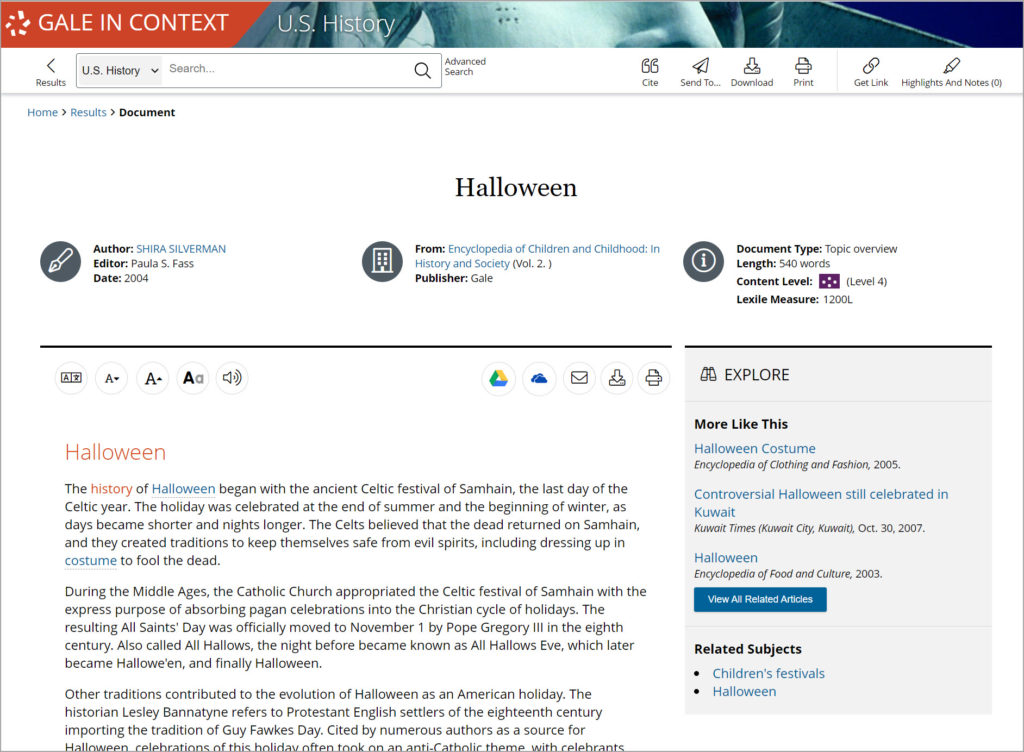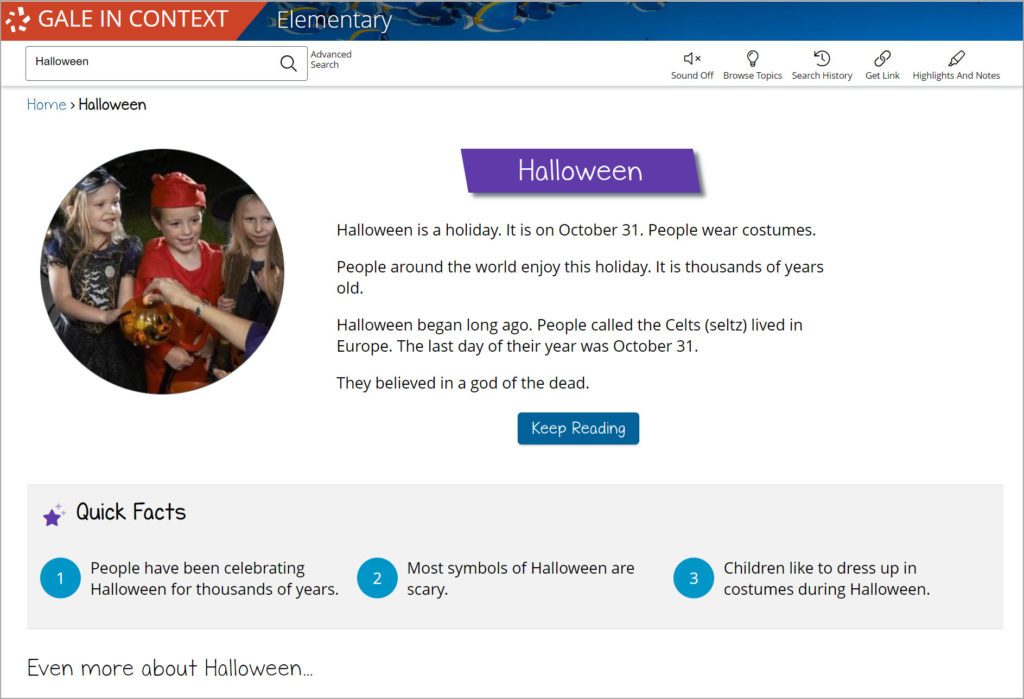| By Gale Staff |
Take Your Students on a Journey with Gale In Context Resources
Classrooms in October are packed with fake cobwebs, snack-size candy bars, and other delightful Halloween decor and treats. For elementary school teachers, the last week in October is the perfect time to create fun Halloween lesson plans and activities for students. There’s no end to the educator resources available online, but a blanket Google search can be more overwhelming (and often unreliable) than it’s worth. Educational technology doesn’t have to be complicated—this year, save yourself from the terror and start your Halloween lesson planning with Gale In Context resources.
Instead of bobbing for content, dive into a treasure trove of Halloween history with Gale In Context: U.S. History and Gale In Context: Elementary. With a simple search, you’ll find reference articles, videos, biographies, magazines, audio files, academic journal entries, news pieces, and images. Gale databases make it easy for users to filter results, so teachers, librarians, and even your elementary students can quickly find relevant resources for any topic.
Explore Halloween’s Ancient Traditions
While modern Halloween is defined by costumes and candy, the holiday has some very interesting roots. October 31st was once better known as Samhain, an ancient Celtic agrarian holiday that marked the beginning of the winter season. Halloween’s ghostly traditions can be traced to its Celtic history. It was once believed that on Halloween, the boundaries between the human world and that of the supernatural were open—meaning ghosts and mystical creatures were free to walk among us. Halloween was meant to celebrate all that was supernatural and other-worldly. Celtic priests even built massive bonfires, and locals would sacrifice plants and animals to the fire.

Eventually, these Pagan customs adapted to a more secular influence, and the religious components faded. The celebration was largely only practiced in Great Britain and involved participants dressing in supernatural-themed costumes to visit nearby neighbors, who would lay out food and drink in tribute. The customs didn’t enter American culture until the mid-nineteenth century when the Irish began immigrating to the United States.
Learn How the Holiday Evolved
It was the Irish who introduced the custom of pranking into the holiday; what started as playful soon became destructive. By the early 1900s, American cities were experiencing costly Halloween pranks, such as a group of boys who lit sticks of dynamite on their school’s grounds. In response to the holiday’s chaos, many considered banning Halloween entirely. However, some ingenious parents came up with a solution: distract the wily children with treats instead. Neighbors then began hosting small parties for local children to attend and receive some kind of gift or sweet. Thus, trick-or-treating was born.
Encourage your students to consider how ancient customs continue to influence modern Halloween celebrations. Carving pumpkins and bobbing for apples suggest the holiday’s agricultural significance, as both crops are bountiful during this time of year. Children still dress in supernatural costumes (witches, ghosts, and zombies) before visiting their neighbors for treats. And there are all kinds of haunted houses and mischievous activities for Halloween night, reminiscent of those troublesome youth in early America.
Have Fun With Gale In Context Tools
All Gale In Context articles include a colorful highlighting function and other interactive research tools; you can even find citations at the bottom that you can customize to fit your research format. What’s more, Gale In Context‘s Halloween-related results offer a range of subtopics related to your search, helping students pursue a variety of research paths within one topic.
You can also feel confident in the integrity and age-appropriateness of these search results. Gale in Context introduces readers to topics with a quick summary and fun, simple facts. Articles and other resources are filtered for different grade levels. Your elementary learners will find engaging, easy-to-read Halloween history articles and tidbits that are accessible to them, like this chart ranking the most popular Halloween candies (Hint: Snickers, M&Ms, and Reese’s Cups are just a few). No matter which direction you take with your lesson plans, Gale In Context is designed with the needs and interests of students in mind. Plus, these resources ensure that students can learn research skills in a safe, structured environment.

Halloween celebrations outside the classroom feature yummy treats and creative costumes. But you can also easily integrate meaningful learning into this season’s school activities. This spooky season, start your Halloween research with Gale In Context: Elementary and Gale In Context: U.S. History.
Not a Gale In Context subscriber? Request a trial or speak to your rep today!

